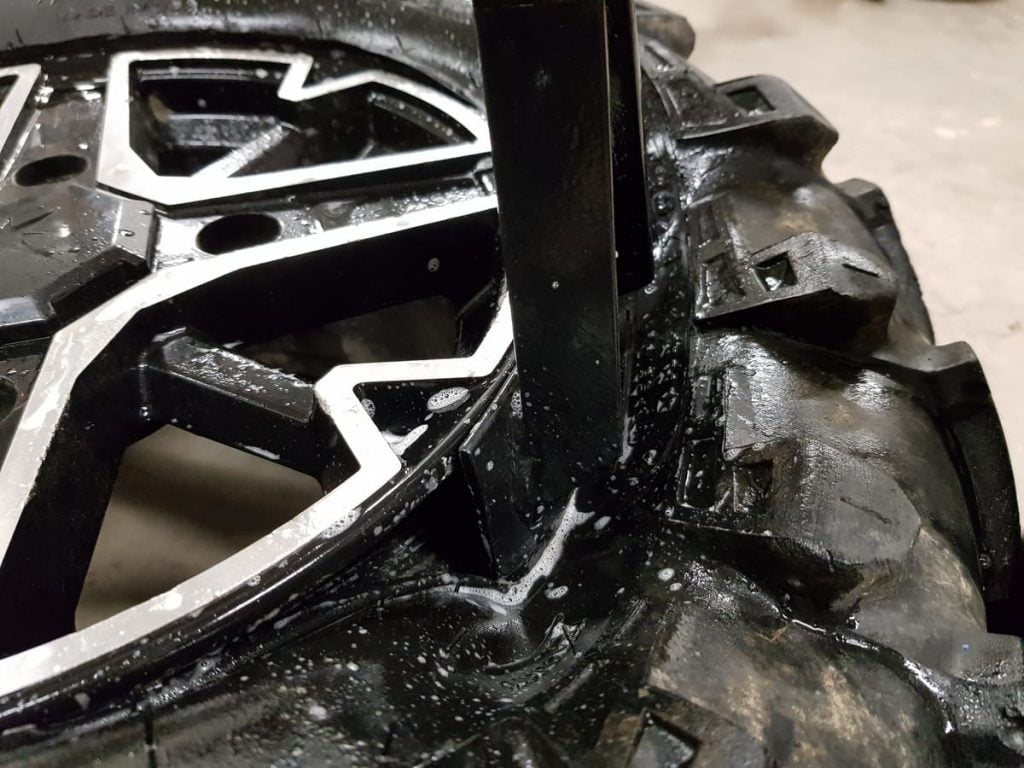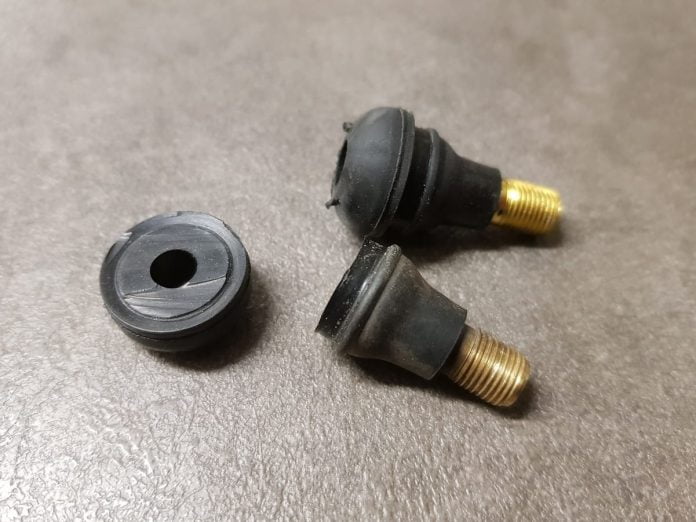It’s not uncommon for valve stems to leak only after a few years of use due to dirt, corrosion, road salt, or degraded rubber. Luckily, they are relatively cheap and easy to replace at home.
The same basic principles in this guide apply to most tubeless tires, whether on an ATV, car, lawnmower, or snowblower.
A tire shop may charge around $20 to $30 to change a valve stem. If you do the job yourself, it will cost about 5$, depending on what tools you choose and have at your disposal.
I’ve made this guide for those who wish to do the job at home to save a few bucks or don’t have a tire shop nearby.
The guide includes two methods; one where the wheel must come off the rim and one where the valve can be replaced with the tire still on the rim using a specialist tool.
Tools and Supplies You Will Need
You can replace a valve stem with the tools most people already have in their garage. However, to make the job easier, faster, and safer, we recommend that you get a couple of cheap tire tools available at most auto supply stores.
- New valve stems in the correct size.
- Tire jack.
- Lug nut wrench.
- Tools or supplies to de-bead the tire from the rim.
- Sharp knife.
- Pliers (optional).
- Valve stem removal tool or small-size needle-nose pliers.
- Air compressor with a tire inflator.
- Dish soap or vegetable oil. Soapy water will work also.
- Valve stem pull-tool, several cheap options are available.

How to Know What Valve Stem Size You Need
Valve stems come in a range of sizes. They vary in diameter and length, depending on the size and style of wheel you have.
A design number is used to categorize the various types and sizes of valves available.
Let’s use the most common valve for ATVs as an example: TR-412.
- TR stands for tubeless rubber. This tells you the valve is intended for wheels that use tubeless tires.
- 4 tells us what diameter hole the plug will fit. Most ATVs use valve stems with a diameter of 0.453 inches (11.5mm). The next size up is 0.625″ (16mm), which is less common.
- 12 indicates the length of the valve stem. Standard length ratings used in ATV tires are 12, 13, and 14, where 12 is the shortest.
Industry Valve Number | Maximum Inflation Pressure (PSI) | Effective Length (in) | Rim Hole Diameter (in) |
412 | 65 | 0.88 | 0.453 |
413 | 65 | 1.25 | 0.453 |
414 | 65 | 1.50 | 0.453 |
415 | 65 | 1.75 | 0.453 |
418 | 65 | 2.00 | 0.453 |
423 | 65 | 2.50 | 0.453 |
415 | 65 | 1.25 | 0.625 |
425 | 65 | 2.00 | 0.625 |
You will find the design number of your old valve stem stamped on the bottom of the stem. However, this does require removing the valve stem or the tire from the rim.

Alternatively, you can measure the old stem and compare your findings with the table above.
- First, measure the outer diameter of your old valve stem close to the rim. It’s going to be slightly bigger than the rim hole diameter. You should be able to tell whether it’s for a 0.453-inch diameter hole or if it’s for a noticeably larger hole.
- Next, measure the length of the exposed portion of the valve stem from the rim to the tip of the threaded portion of the stem. This is the valve stem’s effective length.

How to Replace a Valve Stem (Step-By-Step):
1. Remove the Tire From the Vehicle
You can move straight to step 2 if you know how to remove the wheel from the vehicle safely.
- Park the vehicle on a flat, hard surface, like a garage floor or a paved driveway.
- Put it in “park” and apply the parking brake.
- Place the tire jack on a sturdy part of the vehicle—the frame on an ATV or a jack mounting point on a car.
- Use the correct size lug nut wrench, and loosen the lug nuts.
- Jack up the vehicle so that the tire lifts from the ground. Secure it with jack stands.
- Remove the lug nuts entirely and remove the tire.
2. Deflate the Tire by Removing the Valve Stem Core
Remove the valve cap, then use a valve stem core removal tool to unscrew the valve stem core from the valve stem. This will release the air from the wheel.

If you don’t have a valve stem removal tool, you should be able to unscrew the core with small needle-nose pliers. Place the pliers on the flat portion of the core, and turn anti-clockwise. You could even use a pair of tweezers in a pinch, as long as they fit.
3. Break the Tire Bead
Next, you need to break the tire bead from the rim.

I tend to use my portable tire changer, but you can de-bead a tire in several ways. Click here to find a list of alternatives for home mechanics to choose from.
After successfully de-beading the tire, place your knee or a wood block between the rim and the tire for easy access to the bottom portion of the valve stem.
You only have to de-bead the side of the wheel with the valve stem. I removed the tire from the wheel completely to take better photos for this post, but this is unnecessary.
4. Cut or Pull Out the Old Valve Stem
To remove the old stem, you have two options.
You can use a sharp knife to cut it, either on the outside or inside the rim. Cut as close to the rim as possible without scratching the rim itself.

After cutting, you should be able to easily pop out the remaining piece of the stem.

Alternatively, you could use a pair of vice grips to pull the plug out from the inside of the tire. Use this method if you plan on reusing the valve stem.
Spray some soapy water on the rim’s outside and inside as lubrication. Place the grips over the stem’s thick portion and use leverage to pull the plug out. You may need to reposition the tool several times for better grip until you get the core out.
5. Prepare the New Valve Stem
Before installing the new valve stem, lube the rubber portion so it slips into place much more effortlessly.
Use dish soap, some vegetable oil, or spray the new valve with a generous amount of soapy water.
Notice: Do not use petroleum-based products such as oil or grease, as it will degrade the rubber over time.

6. Insert the New Valve Stem From Inside the Rim
Insert the valve stem through the hole from the inside of the rim. Make sure the hole is clean and free of debris. The threaded part should protrude on the outside of the rim.

7. Attach a Threaded Pulling Tool to the Valve Stem
You will need a valve stem pull tool to pull the plug in place. You can find them at most auto supply stores at an affordable price.
These tools come in various shapes, but all work with the same basic principle.
The threaded portion of the tool mounts to the valve stem core’s threads to get a good grip.

Do not use pliers to pull the valve stem, which will likely damage the soft copper threads.
8. Pull Out Until the Valve Pops in Place
Use the tool to pull the valve stem straight out from the wheel until the valve stem rubber groove pops in place.



9. Seat the Tire Back on the Rim and Inflate
The tire is seated back on the rim by using compressed air. This will press the tire outwards until it pops over the tire bead and rests against the rim’s lip.
Lube the tire and tire bead with soapy water. This allows you to seat the tire without excess pressure, which could blow out the tire’s side.
The key to success lies in adequately narrowing the gap between the rubber and the rim before you begin to inflate.
You should be able to close the gap manually on softer and smaller tires. However, on tires with stiffer sidewalls, you may be unable to create a tight enough seal to build up pressure.
I prefer using the ratchet strap trick, as this works great most of the time.

Use a ratchet strap to press the tire walls out against the rim. Attach the strap as shown in the picture and tighten it until the tire touches the rim.
With the valve stem core removed, add air until the bead pops in place. Never exceed 7-8 PSI with the strap attached.
As soon as the tire seats, deflate it, remove the strap, and install the valve stem core before inflating the tire according to spec.
You are now done and can install the tire back on the vehicle.
How to Replace a Valve Stem Without Removing the Tire From the Rim
The hardest part of replacing a valve stem from the inside is getting the tire off the rim.
If you don’t have the tools or don’t feel comfortable with the idea of de-beading a tire, consider getting a valve-changing tool kit designed to replace a valve stem from the outside.
Getting the hook past the old valve stem can be a bit fiddly. Use plenty of soapy water as a lube, and be careful not to damage or scratch the rim, as this could cause a leak.
FAQ
What is a valve stem?
A valve stem is a component of a tire that allows air to be pumped into the tire. It includes a valve to prevent air from escaping.
How do I know if my valve stem is bad?
If you’re experiencing slow leaks or rapid deflation of your tire, the valve stem might be damaged or worn out.
How long does a valve stem last?
Valve stems usually last as long as the tire. It’s a good idea to replace them when you replace your tires.
Are all valve stems the same size?
No, valve stems come in different sizes depending on the type of vehicle. Make sure you purchase the right size for your tire.
Wrapping Up
Mastering DIY auto maintenance tasks such as valve stem replacement allows you to have better control over your vehicle’s health. With patience and practice, you can make minor repairs without seeking professional assistance, making you self-reliant in unexpected situations. Keep exploring, keep learning, and drive safe!
